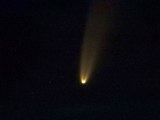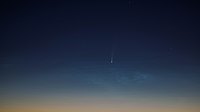Comet NEOWISE: Difference between revisions
5km<ref name="discovery_date"/> |
|||
| Line 49: | Line 49: | ||
By July 5 NASA's [[Parker Solar Probe]] captured an image of the comet, from which astronomers estimated that the diameter of the [[comet nucleus]] is approximately 5 km.<ref>{{citation |url=https://apod.nasa.gov/apod/ap200711.html |title=The Tails of Comet NEOWISE |publisher=NASA |date=11 July 2020 |author1= Miloslav Druckmuller |author2= Robert Nemiroff |author3=Jerry Bonnell}}</ref><ref name="discovery_date"/> |
By July 5 NASA's [[Parker Solar Probe]] captured an image of the comet, from which astronomers estimated that the diameter of the [[comet nucleus]] is approximately 5 km.<ref>{{citation |url=https://apod.nasa.gov/apod/ap200711.html |title=The Tails of Comet NEOWISE |publisher=NASA |date=11 July 2020 |author1= Miloslav Druckmuller |author2= Robert Nemiroff |author3=Jerry Bonnell}}</ref><ref name="discovery_date"/> |
||
According to [[British Astronomical Association]], the comet brightened from a magnitude of about 8 at the beginning of June to -2 in early July.<ref>{{citation |url=https://people.ast.cam.ac.uk/~jds/ |publisher=British Astronomical Association |work=Comet Section |author=Nick James |title=Visual observations page |date=6 July 2020}}</ref> This would make it brighter than Hale Bopp. However as it was very near to the Sun it was reported as 0 or +1 magnitude and remained that bright for only a few days. After perihelion the comet began to fade at about the same rate as it had previously brightened. When approaching to closest approach to Earth,{{when}} the comet was fading 0.4 magnitudes per day, so is expected to remain visible to the naked eye until that date.<ref>{{citation |
According to [[British Astronomical Association]], the comet brightened from a magnitude of about 8 at the beginning of June to -2 in early July.<ref>{{citation |url=https://people.ast.cam.ac.uk/~jds/ |publisher=British Astronomical Association |work=Comet Section |author=Nick James |title=Visual observations page |date=6 July 2020}}</ref> This would make it brighter than Hale Bopp. However, as it was very near to the Sun, it was reported as 0 or +1 magnitude and remained that bright for only a few days. After perihelion, the comet began to fade at about the same rate as it had previously brightened. When approaching to closest approach to Earth,{{when}} the comet was fading 0.4 magnitudes per day, so is expected to remain visible to the naked eye until that date.<ref>{{citation |
||
|url=https://people.ast.cam.ac.uk/~jds/}}</ref>{{fcn}} |
|url=https://people.ast.cam.ac.uk/~jds/}}</ref>{{fcn}} |
||
Revision as of 13:54, 13 July 2020
 C/2020 F3 NEOWISE photographed on July 9, 2020 through a 11" telescope | |
| Discovery | |
|---|---|
| Discovered by | NEOWISE |
| Discovery date | March 27, 2020[1] |
| Orbital characteristics | |
| Epoch | 2458953.5 (April 14, 2020) |
| Number of observations | 353 |
| Aphelion | 544 AU (inbound) 720 AU (outbound) |
| Perihelion | 0.29478 AU |
| Semi-major axis | 272 AU (inbound) 360 AU (outbound) |
| Eccentricity | 0.99921 |
| Orbital period | ~4500 yrs (inbound)[2] ~6800 yrs (outbound) |
| Inclination | 128.93° |
| Last perihelion | July 3, 2020 |
| TJupiter | -0.408 |
| Earth MOID | 0.36 AU (54 million km; 140 LD) |
| Jupiter MOID | 0.81 AU (121 million km) |
| Physical characteristics | |
| Dimensions | ~5 km[1] |
C/2020 F3 (NEOWISE), or Comet NEOWISE, is a retrograde comet with a near-parabolic orbit discovered on March 27, 2020, by astronomers using the NEOWISE space telescope.[3] By July 2020 it was bright enough to be visible to the naked eye. For observers in the northern hemisphere, in the morning the comet appears low on the northern-eastern horizon, below Capella. In the evening it can be seen in the north-western sky. In the second half of July 2020 it will appear to pass through the constellation of Ursa Major, below the asterism of The Plough (Big Dipper).
Under dark skies it can be clearly seen with the naked eye[4] and is expected to remain visible to the naked eye throughout most of July 2020.[3]
History and observations

The object was discovered by a team using the NEOWISE space telescope on 27 March 2020.[1] It was classified as a comet on 31 March and named after NEOWISE on 1 April.[5] It has the systematic designation C/2020 F3, indicating a non-periodic comet which was the third discovered in the second half of March 2020.
Comet NEOWISE made its closest approach to the Sun (perihelion) on July 3, 2020, at a distance of 0.29 AU (43 million km). This passage increases the comet's orbital period from about 4500 years to about 6800 years.[2]
Seen from Earth, the comet was less than 20 degrees from the Sun between June 11 and July 9, 2020. By June 10, 2020, as the comet was being lost to the glare of the Sun, it was apparent magnitude 7.[6] When the comet entered the field of view of the SOHO spacecraft's LASCO C3 instrument on June 22, 2020, the comet had brightened to magnitude 3.[6][7][unreliable source?]
By early July, Comet NEOWISE has brightened to magnitude +1,[8][9] far exceeding the brightness attained by C/2020 F8 (SWAN), and had developed a second tail. The first, blueish tail is made of gas and ions and the later second, golden tail is made of dust, like that of Comet Hale-Bopp. It is brighter than C/2011 L4 (PANSTARRS), but not as bright as Hale–Bopp was in 1997.
By July 5 NASA's Parker Solar Probe captured an image of the comet, from which astronomers estimated that the diameter of the comet nucleus is approximately 5 km.[10][1]
According to British Astronomical Association, the comet brightened from a magnitude of about 8 at the beginning of June to -2 in early July.[11] This would make it brighter than Hale Bopp. However, as it was very near to the Sun, it was reported as 0 or +1 magnitude and remained that bright for only a few days. After perihelion, the comet began to fade at about the same rate as it had previously brightened. When approaching to closest approach to Earth,[when?] the comet was fading 0.4 magnitudes per day, so is expected to remain visible to the naked eye until that date.[12][full citation needed]
Closest approach to Earth will occur July 23, 2020, 01:14 UT, at a distance of 0.69 AU (103 million km). It will appear in the constellation of Ursa Major.[13]
Trajectory

Gallery
-
July 7, 2020, Landers, California
-
July 8, 2020 from Zuzici, Istria, Croatia
-
With noctilucent clouds, July 8
-
Comet C/2020 F3 (NEOWISE) on July 9, over Split, Croatia
-
C/2020 F3 (NEOWISE) Over Borča, Belgrade, Serbia on July 10. 2020, 3:48AM
-
C/2020 F3 (NEOWISE) On July 10, 2020 from Beinwil am See, Switzerland
-
C/2020 F3 (NEOWISE) July 7, near Sursee, Central Switzerland
-
Comet C/2020 F3 NEOWISE moving west across a few stars. Nine 15 second exposures taken over ~5 minutes starting at 4:23 am EDT on July 10th, 2020 from Brampton, Ontario. FOV: 36.5' x 36.5'
-
C/2020 F3 Comet Neowise taken over the Antelope Valley, Ca. 07-10-2020 at 4:30 am.
References
- ^ a b c d Mace, Mikayla (July 8, 2020). "Comet NEOWISE Sizzles as It Slides by the Sun, Providing a Treat for Observers". Infrared Processing and Analysis Center. Retrieved July 13, 2020.
- ^ a b JPL Horizons barycentric solution for epoch 1950 (before entering planetary region)
Goto JPL Horizons
Ephemeris Type: Orbital Elements
Center: @0 (Solar System Barycenter)
Time Span: 1950-01-01 to 2050-01-01 and Step Size: 100 years
1950-Jan-01 is "PR= 1.63E+06 / 365.25 days" = 4462 years
(For long period comets on multi-thousand year orbits, asymmetric outgassing will affect the highly sensitive orbital period and eccentricity.) - ^ a b Seiichi Yoshida. "C/2020 F3 ( NEOWISE )". Retrieved April 4, 2020.
- ^ "How to see Comet NEOWISE". EarthSky. Retrieved July 11, 2020.
- ^ "COMET C/2020 F3 (NEOWISE)". Minor Planet Electronic Circulars. 2020-G05. April 1, 2020. Retrieved July 13, 2020.
On behalf of NEOWISE (C51), J. Masiero reported on March 31 UT that this object showed clear signs of cometary activity.
- ^ a b "Comet Observation database (COBS)". Retrieved May 27, 2020. "C/2020 F3 (NEOWISE) plot"
- ^ SOHO LASCO C3 – Michal Kusiak
- ^ "Comet F3 NEOWISE May Perform in July". Universe Today. Retrieved June 30, 2020.
- ^ "ATel #13853: Morphology and Photometry of Comet C/2020 F3 (NEOWISE) from SOHO". Astronomer's Telegram. July 2, 2020.
- ^ Miloslav Druckmuller; Robert Nemiroff; Jerry Bonnell (July 11, 2020), The Tails of Comet NEOWISE, NASA
- ^ Nick James (July 6, 2020), "Visual observations page", Comet Section, British Astronomical Association
- ^ https://people.ast.cam.ac.uk/~jds/
{{citation}}: Missing or empty|title=(help) - ^ JPL Horizons closest approach to Earth
Goto JPL Horizons
Ephemeris Type: Observer
Observer Location: 500 (Geocentric)
(Closest approach occurs when deldot flips from negative to positive)
External links
- C/2020 F3 (NEOWISE) – CometWatch
- C/2020 F3 (NEOWISE) – AiM-Project-Group
- C/2020 F3 (NEOWISE) – Ernesto Guido & Adriano Valvasori
- C/2020 F3 (NEOWISE) on YouTube – ISS view (video; 7:00; 7 July 2020)
- C/2020 F3 (NEOWISE) on YouTube – Tom Polakis; 300frms/20mins (video; 0:10; 7 July 2020)
- Comet NEOWISE at the JPL Small-Body Database













